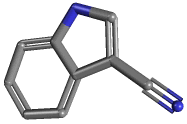|
3-CYANOINDOLE |
| Synonyms. 3-Cyanoindole; 1H-Indole-3-carbonitrile; Indole-3-carbonitrile; 3-Indolecarbonitrile; 1H-indole-3-kohlenitrile; |
|
|
| PRODUCT IDENTIFICATION | |
|
CAS RN |
5457-28-3 |
|
EINECS RN |
201 |
|
FORMULA |
C9H6N2 |
|
MOLE WEIGHT |
142016 |
|
H.S CODE |
2933.99.7900 |
|
SMILES |
C1=CC=C2C(=C1)C(=CN2)C#N |
|
CLASSIFICATION |
|
|
EXTRA NOTES |
|
|
|
| PHYSICAL AND CHEMICAL PROPERTIES | |
|
PHYSICAL STATE |
off-white to yellow powder |
|
MELTING POINT |
179 ~ 182 C |
|
BOILING POINT |
|
|
DENSITY |
|
|
SOLUBILITY IN WATER |
|
| SOLVENT SOLUBILITY |
|
|
VAPOR DENSITY |
|
|
log P(octanol-water) |
|
|
VAPOR PRESSURE |
|
|
AUTOIGNITION TEMP |
|
| pK |
|
|
REFRACTIVE INDEX |
|
|
FLASH POINT |
|
|
|
| STABILITY AND REACTIVITY | |
| STABILITY | Stable under normal conditions. |
|
INCOMPATIBLE MATERIALS |
Strong oxidizing agents. |
| POLYMERIZATION |
Has not been reported |
|
NFPA RATINGS |
Health: 2, Flammability: 1, Reactivity: 0 |
|
|
| EXTERNAL LINKS & GENERAL DESCRIPTION |
|
USA.gov - 3-Cyanoindole Google Scholar Search - 3-Cyanoindole U.S. National Library of Medicine - 3-Cyanoindole PubChem Compound Summary - 3-Cyanoindole NCBI (http://www.ncbi.nlm.nih.gov/) - 3-Cyanoindole http://www.sigmaaldrich.com/ |
|
|
| SALES SPECIFICATION | |
|
APPEARANCE |
off-white to yellow powder |
|
ASSAY |
98.0% min |
|
MELTING POINT |
179 ~ 182 C |
| ASH |
0.2% max |
|
LOSS ON DRYING |
0.5% max |
|
HEAVY METALS |
10ppm max |
|
|
| TRANSPORT & REGULATORY INFORMATION | |
|
UN NO. |
|
| HAZARD CLASS |
|
| PACKING GROUP | |
|
|
| SAFETY INFORMATION | |
|
HAZARD OVERVIEW |
GHS (Globally Harmonised System) Classification: Acute toxicity (Inhalation, Dermal, Oral). Skin irritation. Eye irritation. Specific target organ toxicity - single exposure. Hazard statements: Harmful if swallowed or in contact with skin. Causes skin irritation. Causes serious eye irritation. Harmful if inhaled. May cause respiratory irritation. |
| SIGNAL WORD | Warning |
|
PICTOGRAMS |
|
|
HAZARD STATEMENTS |
H302 + H312-H312-H315-H319-H332-H335 |
|
P STATEMENTS |
P261-P280-P305 + P351 + P338 |
| EC DIRECTIVES |
|
| HAZARD CODES |
|
|
RISK PHRASES |
20/21/22-36/37/38 |
|
SAFETY PHRASES |
26-37/39 |
|
|
| PACKING |
|
Preserved in light-resistant and well-closed bottles |
|
|
| PRICE INFORMATION |
|
|

